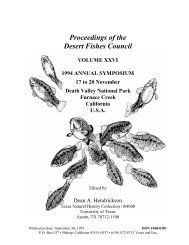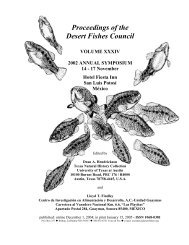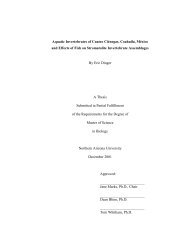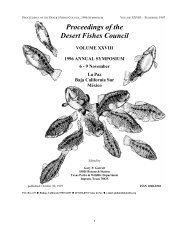Proceedings of the Desert Fishes Council 2000
Proceedings of the Desert Fishes Council 2000
Proceedings of the Desert Fishes Council 2000
Create successful ePaper yourself
Turn your PDF publications into a flip-book with our unique Google optimized e-Paper software.
PROCEEDINGS OF THE DESERT FISHES COUNCIL - VOLUME XXX1I (<strong>2000</strong> SYMPOSIUM) – PUBLISHED NOVEMBER 13, 2001<br />
remanso aisladas (y la investigación asociada, de la Fase IV) inició en diciembre de 1999. Se espera que en<br />
otoño del <strong>2000</strong> inicien investigaciones similares sobre el bagre piltonte [Pylodictis olivaris].<br />
Webster, T 1 ; Unmack, PJ 2<br />
(1-<strong>Desert</strong> Springs Action Committee; 2-Arizona State University, Department <strong>of</strong> Biology)<br />
Ash Meadows: a photographic perspective 1938-<strong>2000</strong><br />
ABSTRACT<br />
Ash Meadows has played an important role in <strong>the</strong> conservation movement in <strong>the</strong> American West, especially<br />
in <strong>the</strong> formation <strong>of</strong> <strong>the</strong> <strong>Desert</strong> <strong>Fishes</strong> <strong>Council</strong>. This was due to its permanent water supply in an o<strong>the</strong>rwise<br />
parched landscape, which attracted <strong>the</strong> attention <strong>of</strong> ranching and housing developers who vastly modified <strong>the</strong><br />
aquatic habitats. Fortunately, environmental concerns ruled <strong>the</strong> day and ultimately resulted in <strong>the</strong> formation <strong>of</strong><br />
<strong>the</strong> Ash Meadows Wildlife Refuge. Due to <strong>the</strong> significance <strong>of</strong> <strong>the</strong> area and <strong>the</strong> interest in its conservation, many<br />
photographs exist from <strong>the</strong> late 1960s and early 1970s. Fewer photos exist prior to this time. Present efforts are<br />
focusing on locating additional photographs from all time periods, as it is difficult to get series <strong>of</strong> images<br />
suitable for comparison due to differences in photographic perspective. However <strong>the</strong>re is sufficient<br />
documentation for a basic comparisons <strong>of</strong> changes from when Robert Rush Miller began his studies <strong>the</strong>re in<br />
1938. A major hiatus exists until <strong>the</strong> late 1960s when many students, pr<strong>of</strong>essors and o<strong>the</strong>rs involved with <strong>the</strong><br />
"proto" <strong>Desert</strong> <strong>Fishes</strong> <strong>Council</strong> spent much time in <strong>the</strong> area, many <strong>of</strong> whom photographed habitats. Our own<br />
involvement in Ash Meadows began in 1994-5 and is continuing. Several springs have good series <strong>of</strong> photos<br />
that provide an indication <strong>of</strong> changes over time. These include Big, Jackrabbit, Kings Pool, Point <strong>of</strong> Rocks,<br />
Crystal, Longstreet, Rogers, and Fairbanks. These photographic comparisons allow both anthropogenic and<br />
natural changes over time to be recorded. They also document nature's ability to recover from seemingly total<br />
devastation, both <strong>of</strong> which are useful in restoration efforts.<br />
RESUMEN<br />
Ash Meadows [Praderas Ash]: una perspectiva fotográfica de 1938 a <strong>2000</strong><br />
El área de las Praderas Ash ha jugado un papel importante en el movimiento conservacionista del oeste de<br />
los Estados Unidos, sobre todo en la formación del Consejo de los Peces del Desierto. Ello se debió al suministro<br />
permanente de agua a un paisaje que de otro modo sería árido, esto atrajo la atención de desarrolladores de<br />
ranchos y viviendas, quienes modificaron inmensamente los hábitats acuáticos. Por fortuna, la conciencia<br />
ambiental prevaleció y al final resultó en la formación del Refugio para Vida Silvestre de Ash Meadows. Debido<br />
a lo significativo del área y al interés en su conservación, se cuenta con muchas fotografías de finales de los<br />
1960s e inicios de los 1970s, aunque se cuenta con pocas fotografías previo a estos años. Se está realizando un<br />
esfuerzo por localizar fotografías de todas las épocas posibles; es difícil conseguir series de imágenes para fines<br />
comparativos en razón de las diferentes perspectivas de las fotografías. Existe, sin embargo, suficiente<br />
información para realizar comparaciones básicas de cuando Robert Rush Miller inició sus estudios allí en 1938.<br />
Hay un hueco importante hasta finales de los 1960s cuando muchos estudiantes, académicos y otras personas<br />
involucradas en el “proto” Consejo de los Peces del Desierto pasaron bastante tiempo en el área, muchos de ellos<br />
fotografiando los hábitats. Nosotros nos involucramos en este área desde 1994-95. Hay buenas series de<br />
fotografías para varios manantiales, con los cuales es posible detectar cambios temporales. Entre estos<br />
manantiales están: Big, Jackrabbit, Kings Pool, Point <strong>of</strong> Rocks, Cristal, Longstreet, Rogers, y Fairbanks. Las<br />
comparaciones fotográficas permiten registrar cambios temporales, tanto antropogénicos como naturales.<br />
También documentan la capacidad natural para recuperarse de aparentes devastaciones totales; ambos tipos de<br />
registros son de utilidad en proyectos de restauración.<br />
5





![Part 2 [419KK] - Desert Fishes Council](https://img.yumpu.com/14712282/1/190x245/part-2-419kk-desert-fishes-council.jpg?quality=85)



